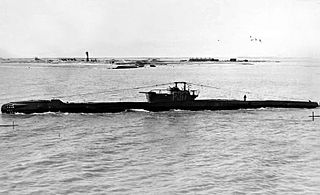
HMS Uganda was a Second World War-era Fiji-class light cruiser launched in 1941. She served in the Royal Navy during 1943 and 1944, including operations in the Mediterranean, and was transferred to the Royal Canadian Navy as HMCS Uganda in October 1944. She served in the Pacific theatre in 1945 and was put into reserve in 1947. When she was reactivated for the Korean War in 1952 she was renamed HMCS Quebec. She was decommissioned for the last time in 1956 and scrapped in Japan in 1961.

HMCS Ontario was a Minotaur-class light cruiser built for the Royal Navy as HMS Minotaur (53), but transferred to the Royal Canadian Navy on completion and renamed Ontario.

HMS Rotherham was an R-class destroyer of the British Royal Navy during the Second World War, named after Captain Edward Rotheram, who commanded HMS Royal Sovereign during at the Battle of Trafalgar in 1805. Rotherham was completed in 1942 and equipped as a flotilla leader, having slightly reduced armament to allow for the increased complement and working space required. Decommissioned in 1945, the ship was sold to India in 1948, serving as INS Rajput (D141) until 1976, when she was scrapped.

HMS Stygian was a S-class submarine of the British Royal Navy, and the only ship so far to bear the name. The boat is listed as being a member of the fourth group, although she had the external stern torpedo tube fitted as in the third group.

HMS Rocket was an R-class destroyer of the Royal Navy that saw service during Second World War. Built by Scotts Shipbuilding and Engineering Company in Greenock, Scotland, she was launched in October 1942 and commissioned in August 1943.

HMCS Crescent was a C-class destroyer that was built for the Royal Navy but was transferred before completion and saw active service with the Royal Canadian Navy. She was one of 32 destroyers of that class built between 1943 and 1945 as part of the War Emergency Programme.

The Shoreham-class sloops were a class of eight warships of the Royal Navy built in the early 1930s.

The second HMS Talisman (N78), and the first to enter service under the name, was a T-class submarine of the Royal Navy. She was laid down by Cammell Laird & Co Limited, Birkenhead and launched on 29 January 1940.

HMS Tetrarch (N77) was a T-class submarine of the Royal Navy. She was laid down by Vickers Armstrong, Barrow and launched in November 1939.

HMS Thule was a British submarine of the third group of the T class. She was built as P325 at Devonport Dockyard, and launched on 22 October 1942. So far she has been the only ship of the Royal Navy to bear the name Thule, after Thule, the mythological name for a northern island.

HMS Token was a British submarine of the third group of the T class. She was built as P328 at Portsmouth Dockyard, and launched on 19 March 1943. So far she has been the only ship of the Royal Navy to bear the name Token.

HMS Tally-Ho was a British submarine of the third group of the T class. She was built as P317 by Vickers Armstrong, Barrow and launched on 23 December 1942. She has been the only ship of the Royal Navy to bear the name, that of the hunting call, "Tally-Ho!".

HMCS New Glasgow was a River-class frigate that served in the Royal Canadian Navy during the Second World War and as a Prestonian-class frigate from 1955 to 1965. She was named for New Glasgow, Nova Scotia.

HMCS Beacon Hill was a River-class frigate that served in the Royal Canadian Navy (RCN) as an ocean convoy escort during the Second World War. She fought primarily in the Battle of the Atlantic. In 1954 she was converted to a Prestonian-class frigate and served until 1957. She was named for Victoria, British Columbia, but because HMS Victorious was in service with the Royal Navy, the RCN, in an effort to avoid confusion, chose to honour the city by choosing another name associated with it.

HMS Thracian was an S-class destroyer built for the Royal Navy during the First World War.

HMS Wren (D88/I88) was an Admiralty modified W class destroyer built for the Royal Navy. She was ordered in April 1918 from Yarrow Shipbuilders Limited under the 13th Order for Destroyers of the Emergency War Program of 1918–19. She was the third Royal Navy ship to carry the name, which was introduced in 1653.

HMCS Swansea was a Canadian River-class frigate that was the most successful U-boat hunter in the Royal Canadian Navy during the Second World War, having a hand in the destruction of four of them. She saw service in the Battle of the Atlantic from 1943 to 1945. Following the war she was refit as a Prestonian-class frigate. She is named for Swansea, Ontario.

The second HMS Wivern, was a Modified W-class destroyer of the British Royal Navy that saw service in World War II.

HMCS Ste. Therese was a River-class frigate that served with the Royal Canadian Navy during the Second World War. She served primarily as a convoy escort in the Battle of the Atlantic. She was named for Sainte-Thérèse-de-Gaspé, Quebec. After the war she was converted to a Prestonian-class frigate and served until 1967.

HMCS Sussexvale was a River-class frigate that served with the Royal Canadian Navy during the Second World War. She served primarily as a convoy escort in the Battle of the Atlantic. She was named for Sussex, New Brunswick. Her name was altered to prevent confusion with other Allied warships named Sussex. After the war she was converted to a Prestonian-class frigate and served until 1966. She was the last frigate launched by the Royal Canadian Navy during the Second World War.




















